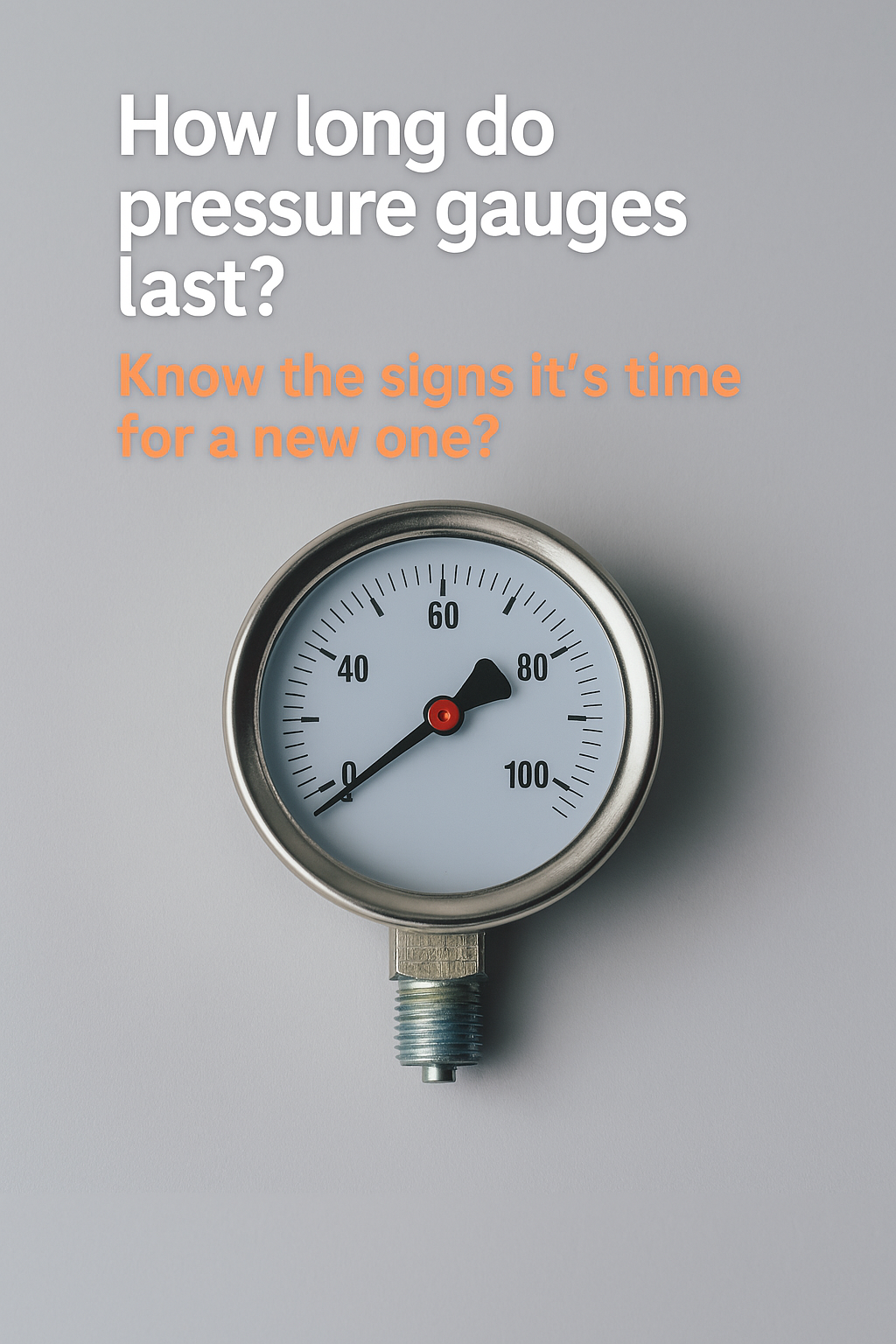
Most people don’t think twice about a pressure gauge until something goes wrong. But in industrial environments, that small dial or digital display can be the only thing standing between smooth operations and costly downtime. It’s not just a “nice to have”–a pressure gauge is a critical component of your industrial equipment.
So, how long do these gauges actually last? And how can you tell when it’s time to replace one before it fails at the worst possible moment?
Let’s dive into the lifespan of pressure gauges, what affects their durability, and the warning signs you can’t afford to ignore.
How Long Does a Pressure Gauge Really Last?
There’s no one-size-fits-all answer here–pressure gauge lifespan depends heavily on the environment, application, and maintenance. That said, under ideal conditions, a well-made gauge can last 5 to 10 years.
But let’s be clear: “ideal conditions” don’t happen often in the real world of industrial equipment. High vibration, temperature fluctuations, corrosive media, and constant pressure cycling can all chip away at a gauge’s longevity. In rougher environments, gauges may only last 2 to 3 years, sometimes even less.
The key takeaway? Just because a gauge can last a decade doesn’t mean it will. Monitoring its health and knowing when to swap it out is far more important than banking on shelf life alone.
What Affects the Lifespan of a Pressure Gauge?
Several factors can shorten–or extend–a pressure gauge’s life. Understanding these can help you choose the right gauge for your setup and avoid early failure.
1. Operating Conditions
Heat, cold, humidity, and vibration aren’t just tough on people–they’re tough on instruments too. Gauges exposed to extreme temperature swings or mechanical vibration are more likely to lose calibration or suffer internal damage over time.
Pro Tip: If your system operates in high-vibration areas, consider liquid-filled gauges. The fluid dampens vibration, protecting the inner mechanism and extending life.
2. Pressure Range and Cycling
Running a gauge constantly at the top of its pressure range is a fast track to wear and tear. It’s recommended to operate within 25% to 75% of the full scale for optimal longevity. Rapid or frequent cycling also stresses the internal components.
Think of it like driving a car at max speed all day—just because it’s possible doesn’t mean it’s sustainable.
3. Media Compatibility
If your gauge isn’t compatible with the process media—whether that’s gas, oil, steam, or a corrosive chemical—it won’t last long. Media that interacts with internal parts or seals can cause clogging, pitting, or corrosion.
Always check chemical compatibility charts when selecting a gauge for a specific application. Don’t guess—because replacing an entire system due to media damage is far more expensive than picking the right gauge upfront.
4. Installation and Maintenance
Improper installation (like using Teflon tape too close to the inlet) or lack of maintenance can damage internal components or cause inaccurate readings. Regular inspections and calibration extend a gauge’s lifespan and ensure it stays reliable.
Warning Signs: When It’s Time to Replace Your Pressure Gauge
Even the best pressure gauges won’t last forever. Here’s what to look for if you’re wondering whether your gauge is still good—or running on borrowed time.
1. Inaccurate Readings
If your readings are off or fluctuating without cause, don’t assume it’s the system—it could be the gauge. Recalibrate if needed, but if the problem persists, it’s likely time for a replacement.
2. Sticking or Pegged Needle
A needle that sticks or constantly pegs at one end is a major red flag. This often indicates internal damage or mechanical failure—both serious enough to warrant immediate attention.
3. Cracks, Leaks, or Fogging
Visible damage to the lens, case, or dial—especially moisture inside the display—suggests the seal has failed. This not only affects readability but compromises the internal components as well.
4. Unresponsive or Lagging Display
In digital gauges, a delayed response or screen glitches may signal internal electronic issues. Don’t rely on a device that’s lagging—it could misreport pressure during critical operations.
5. Excessive Vibration or Noise
If your gauge starts rattling or making unusual noises, chances are the internals are loose or degraded. At that point, replacement is usually more cost-effective than repair.
The Bottom Line
Pressure gauges are like smoke detectors—they’re small, often overlooked, but absolutely essential when something goes wrong. And just like smoke detectors, they need regular checks, occasional calibration, and timely replacement.
If you can’t remember the last time your gauge was inspected, it might be time for a closer look. Don’t wait for a system failure or safety hazard to remind you. Proactive replacement is cheaper, safer, and far less disruptive than dealing with a breakdown in the middle of a production run.
Tip: Build a maintenance log to track installation dates, recalibration intervals, and inspection notes for each gauge in your system. It’s a simple step that can save serious time and money.
Also read: How to Prevent Pressure Gauge Corrosion in Chemical Plants
When your operations rely on accurate pressure readings, cutting corners on gauge maintenance just isn’t an option. Whether you’re monitoring hydraulics, steam, gas, or chemicals, pressure gauges play a crucial role in keeping your industrial equipment running smoothly—and safely.
Need reliable, high-quality pressure gauges you can count on? SS Hussain provides reliable, long-lasting pressure gauges for accurate monitoring and safer operations. Explore our selection today to keep your systems running at their best.
